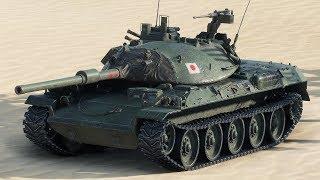

The hydraulic suspension also provides this tank with excellent vertical aiming angles of between -12 and +15 degrees, which move not only by lowering and raising the gun, but by the angle of the hull on the vehicle as a whole. Where necessary, it can raise its hull to fire over a hill, or hide by lowering itself closer to the ground. As for the hydraulic suspension, this innovation allows the STB-1 to adapt perfectly to landscape on various in-game maps. Apart from its unusual regulated hydraulic suspension, the STB-1 will also possess a range of no less important virtues, including excellent mobility, a high rate of fire, and the English L7 cannon with its excellent piercing properties. The STB-1 tank is one of the most advanced Japanese tanks of the latest update. These allowed all the main innovations of the Type 74 to be tested in practice, opening the way for the creation of the next prototype, the STB-3. In total, two identical prototypes, the STB-1 and STB-2, were produced in 1969. In September 1970, the STB-1 successfully completed all its tests, and in October of the same year, it was already participating in a combined arms parade of the Japan Self-Defense Forces. The STB-3 also dispensed with the remote control system for its high-calibre anti-air M2HB machine gun, which proved too slow and impractical when aiming at fast-moving aerial targets.ĭownload Wallpaper: 1280x1024 | 1920x1080 | 2560x1440 This meant that the new STB-3 prototype did not include this system. The system for supplying and extracting shells made the loader’s job significantly easier, but was too expensive to produce. Incidentally, Japan was already independently producing the breech housing and anti-recoil mechanisms for the L7 cannon, buying from abroad only the barrels, the most complex parts to manufacture. The new tank received hydraulic regulated suspension, an in-line control mechanism, a 750 HP diesel engine, a 105mm English L7 cannon with semi-automatic loading, and a remote control system for the anti-air machine gun. However, the STB-1’s cast turret had good lean angles all around it, thanks to which a shell had a high chance of a ricochet when hitting it. The tank’s welded hull received cannon resistant armour only at the front. The tank had a classical layout with the engine and transmission housed in the rear. In June of 1969, after a multitude of trials and bench tests, the STB-1 was given life in metal. In accordance with the basic idea, this new tank was intended to become a fast vehicle with good terrain performance, powerful armament, and a fast-reloading main gun. At the same time, Japan began to develop some of the planned innovations independently and well ahead of time – such as, for example, the hydraulic suspension that was laid out on the draft tables back in 1961, immediately after the Type 61 was deployed.

To achieve maximum universality in this future tank, the designers decided to borrow the most advanced technical solutions from the designs of similar vehicles deployed at the time by NATO countries. These requirements were quite serious: a vehicle had to be created that could go head-to-head against the newest Soviet T-62. The plan for the construction of this fundamentally new tank was actually finally confirmed in 1964, when it became clear to all eminent Japanese experts that the Type 61 could not be modernised sufficiently to fulfill the new requirements. For the 60’s, the STB-1 was an extremely advanced vehicle, and the reason for that was a range of the newest technological solutions used in its creation. The STB-1 is the prototype of the Type 74 main battle tank, designed and tested in Japan in 1969.
#Stb 1 update#
The STB-1 was introduced to War Thunder with update 1.65 “Way of the Samurai”. For its time, this tank was a very technologically advanced vehicle. There may be some problems with news display in specific browser versions. Attention! This news was published on the old version of the website.


 0 kommentar(er)
0 kommentar(er)
